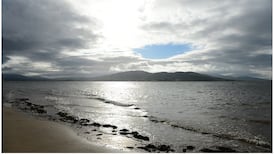Flying low into the wind along the shore, to change one salty lake for another, a line of whooper swans make a ripple of whiteness even brighter than the crests of surf piled up behind them. The wildness of the shore at this time, with flashes of water in every fold of land, send my thoughts up the coast to the tip of Mayo’s Mullet peninsula, where another big white bird often visits in winter.
The snowy owl can seem, perhaps, the whitest bird of all, whether perched on a High Arctic boulder or a rock beside the henge on the brow of Falmore Hill. Like the barnacle geese on the neighbouring Inishkea islands, and the Arctic gyrfalcon, another snowy hunter that follows them there, the owl seems to carry the spirit of chillier latitudes.
The whiteness of so much wildlife is full of paradox and mystery. One seeks to know what the whiteness is "for", as natural selection should keep only changes that improve survival. But how, in the evolution of swans from small dinosaurs, did the four northern swan species go white while those in the southern hemisphere sprout some dark feathers and the native swan in Australia is mostly black?
Camouflage
In the High Arctic, white animals and birds seem to make more obvious sense: whiteness is for camouflage in all that snow and ice, right? But big groups of perennially white hares nibbling poppies on the bog-brown summer tundra could not be more conspicuous. Then, it is the sheer speed of the adults (up to 64km/h) that can save them from foxes and wolves. And it was not camouflage but bitter cold that turned parts of many Irish hares white in the exceptionally hard winter a couple of years ago.
The polar bear, clearly, is not worried about predators; nor does it always look white, depending on the slant of the sun. A mother and daughter I watched from a cliff in northeast Greenland seemed beautifully tinged with gold. The outer hairs of the polar bear’s fur are shiny and stiff, quick to shed water at a shake. They are also hollow, like fine light tubes, and carry short-wavelength energy from the sun to the bear’s black skin. The animal mainly has blubber to keep it warm, but the hollow hairs may also play a part in thermoregulation.
Wolves, foxes and the stoat family all tend to get paler, or even white, the farther north they range, but whiteness in birds, whether whole or in patches, can serve many purposes, from the Arctic to the tropics. Whiteness itself is an absence of colour – keratin, the substance of feathers, is naturally transparent and scatters all frequencies of the spectrum visible to the human eye. Coloured feathers have structures that reflect light selectively or are filled with granules of melanin pigment.
Birds have evolved a much greater variety of colours and patterns than other vertebrate animals. In current scientific debate, the risks of predation – gaudy birds aren’t as good to eat – seem to count for more than sexual selection and display.
Most all-white birds, as it happens, are big enough to take care of themselves, or live on the ocean where predators are fewer. Patches of white plumage can also help seabirds find food. White underparts of gulls, for example, help hide the birds from fish, which see them against a bright sky. This was tested indoors with a pool of schooling fish and two sets of captive, hungry black-headed gulls. Those with underparts dyed black caught fewer fish.
Over the years “Eye on Nature” has received many readers’ reports of white or partly white birds whose plumage or pattern seemed wrong.
There are two ways this can happen, but the difference may be more important to biologists than the average birdwatcher. One is leucism, which prevents melanin from being deposited normally in feathers. This can show up as an overall paleness, or as white patches. Albinism is a genetic mutation that prevents the production of any melanin in the body.
Leucism
and albinism
Melanin is black or dark brown, but other colours come from other pigments, such as the warm hues of carotenoids, so a bird can be albinistic but still have colour. It will, however, have pink eyes, without melanin to mask the blood vessels. Leucism is rare in birds and albinism even rarer. After some disagreement among scientists about what to call birds with white spots, most now accept that white patches are leucistic.
I have seen only one wholly white blackbird, but readers have reported a dozen, along with five white swallows and white or white-patched examples of the following: mallard, sparrow, jackdaw, song thrush, oystercatcher, magpie, greenfinch, goldfinch, siskin, shag, hen harrier and pheasant.
Garden bird tables and feeders have been blamed for distorting avian diets, but this list illustrates the wider role of mutant genes.











